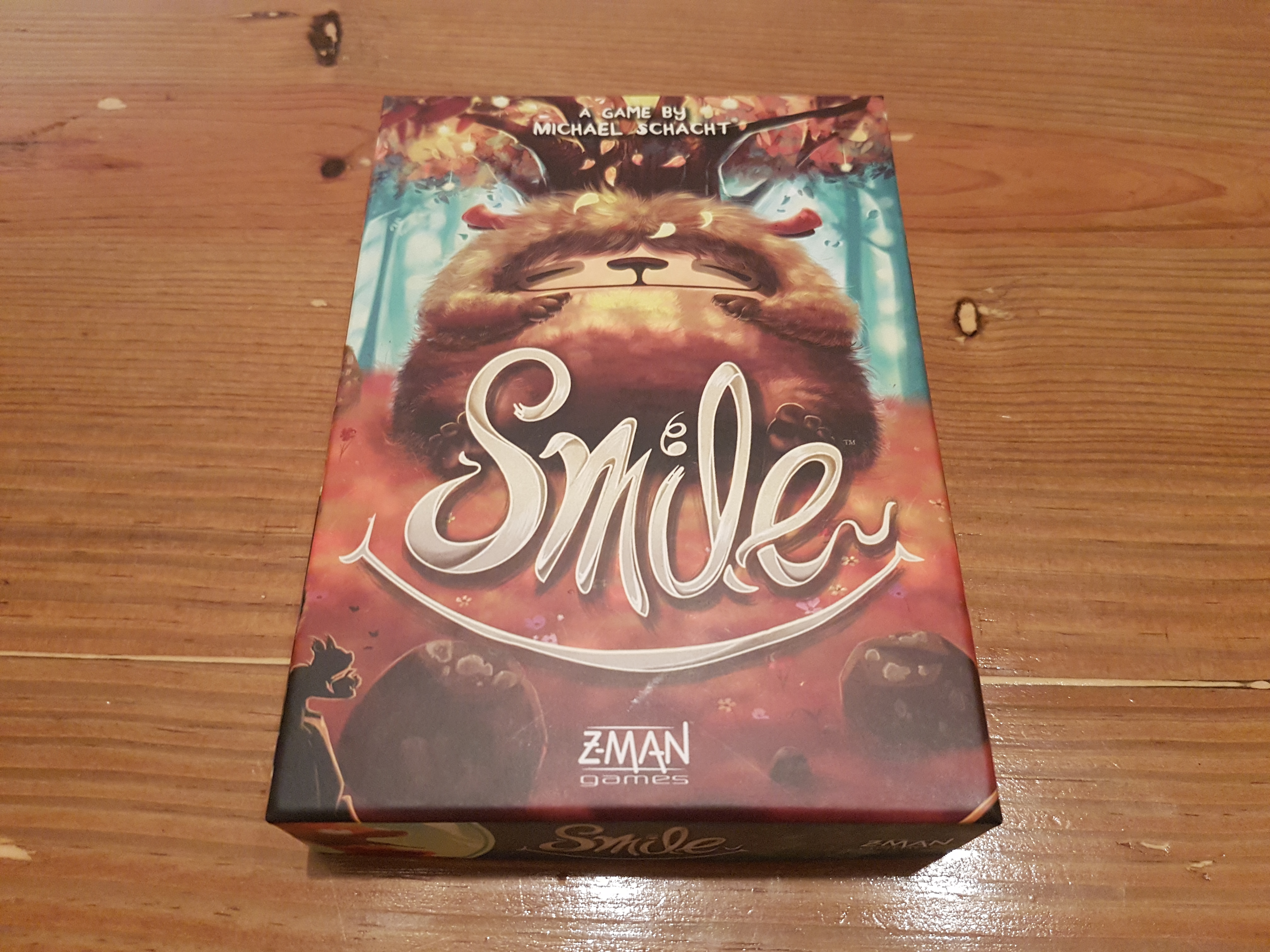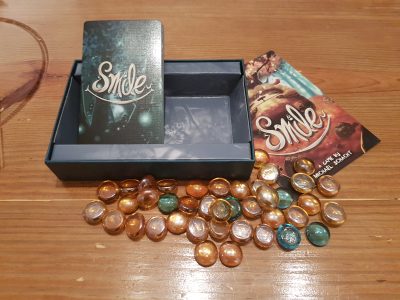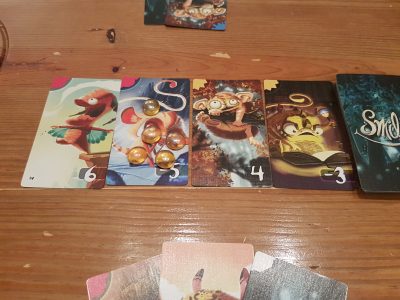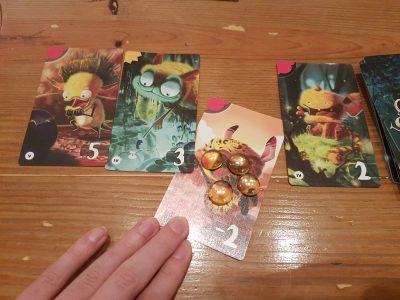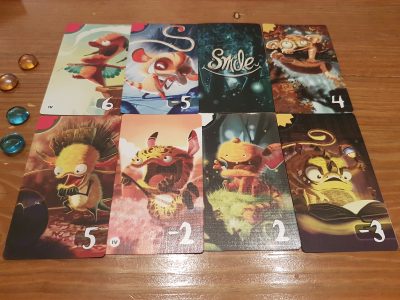Released last year, Smile is a lightweight card game from designer Michael Schacht and publisher Z-Man Games. The game sees 3 – 5 players spend around 30 minutes attempting to tame point scoring critters, whilst using fireflies to avoid others. As the name suggests even the wild critters that players want to avoid will be smiling, yet does the gameplay leave players smiling? Let’s find out!
Setup is almost as quick as taking the components out of the box. Depending on the player count a number of cards get removed and after a quick shuffle the deck is ready. Six glass firefly tokens are given to each player and the game is ready to be played. During this shuffling and distributing of tokens there is even enough time to cover the entire ruleset for new players.
Each round the number of cards equal to the player count are flipped, from the top of the deck, to construct a draw line. On a turn a player must either place a firefly onto the card in the draw line with the lowest point value or, if possible, take a card with fireflies on it. This means that at the start of a round the first player must place a firefly token, as none of the cards have fireflies to start with.
If a player, at any time, cannot place a firefly and doesn’t want to take the card on offer they can choose to take a teardrop. Teardrops, as the name suggests in a game called Smile, are not a good thing: teardrops do gain the player a firefly but at the end of the game are worth -1 point. After receiving a firefly token from taking a teardrop the player can then proceed with their turn and place the firefly onto the card.
Something interesting occurs when two cards with the same number simultaneously become the lowest numbered card. When presented with identical numbers players can choose which of the two cards they wish to place a firefly on. This shakes up the otherwise pedestrian dynamic of players avoiding specific numbers, especially when two -5 cards come out at once!
Once a player decides to take a card they gain it, placing into their personal tableau, and any firefly tokens that were placed onto it. While taking a card means you’re out of the round you then have more chances in the following round. The more fireflies a player has the more times they can choose to skip on taking a card before taking negative points by obtaining teardrops. To make the claiming of cards a bit more interesting than simply gaining, or losing, the points denoted are colours. Not every critter has a colour but when a player gets a pair of the same colour, regardless of the points on offer, the cards cancel each other out. This can see high scoring cards negating each other or conversely an average critter cancelling out a strongly negative card.
The game lasts for 10 rounds, regardless of player count, so scoring big early on isn’t always the best route to take. At the end of the game points are counted from critters still in front of players. For each set of 5 fireflies an additional point is awarded and then points are subtracted for any teardrops collected. The winner is whomever has the most points, meaning they managed to best tame the critters.
After only a few turns it is regrettably obvious that the theme has been pasted on. There’s a real vagueness linking fireflies attracting creatures into why players are doing this, not to mention why the players seem to have pockets full of fireflies. This being said, this is a fast-paced card game and to give meaning of any kind to the cards is often difficult, though far from impossible. Games such as Jaipur have managed to feel like trading at a market, so it is a shame the theme hasn’t been slightly more thought out.
Forgetting the slightly disjointed nature between the game and its theme, the production quality of Smile is fantastic. The artwork, which does have duplicates throughout the deck, features some rather awesome creatures. It uses a mixture of darker colours and still portrays almost cute critters, even with their potentially dangerous teeth being on show. The fireflies could easily have just been cardboard tokens but hiding the glass beads from others and the feel of them to the touch is that bit nicer.
Smile is fun to play in short sharp bursts. Unlike the best fillers on the market, Smile feels pretty much the same each time you play. There’s no major shift in ways to play, no new strategies to try or develop and no matter the player experience the gameplay is identical. This does mean the game is balanced for new players and experienced ones alike, sometimes what is needed from a quick filler. Alas, it also means you cannot play many games of Smile back-to-back.
Players scores will certainly fluctuate throughout the game. While it is to be expected, losing matching coloured cards has frustrated some. A player can be in the lead from the very first round but due to the cards that become available in the final round end up with negative points. Smile does have an air of push your luck and playing the odds to it when risking it to get high scoring cards. The cards are at the end of the day a random draw from the deck, unfortunately it can leave some feeling they have little control over the outcome.
The rules of Smile are extremely short and simple to learn and teach, which gets the game to the table quickly. Despite this, there is one tiny rule that is a frustrating inclusion. Effectively the rules say if you run out of tokens players should just find suitable replacement. This only really applies to teardrops which can run out. House ruling a component based limit on teardrop tokens just made the game flow, without someone having to hunt and find a replacement. It also fixed a punish-the-loser situation. Once a player is in the position of having to take teardrops they are almost stuck in a loop on never having fireflies. If exploited this results in a “kick them while their down” situation that makes even this short game a bit miserable to play.
Smile isn’t a bad game it just does little past the illustrations on the cards to inspire passion. The gameplay mechanisms of either paying to skip a bad card or take it and earn some fireflies works well and leads to a solidly designed game. The game will undoubtedly click with some gaming groups, as there are some take that elements ready to be exploited and entertainment to be had. For me though plays will be few and far between, to give the game a chance to not get repetitive. Falling into the “meh” territory just isn’t enough for board games anymore.
[Editor’s Note: Smile was provided to us by Z-Man Games for the review.]

